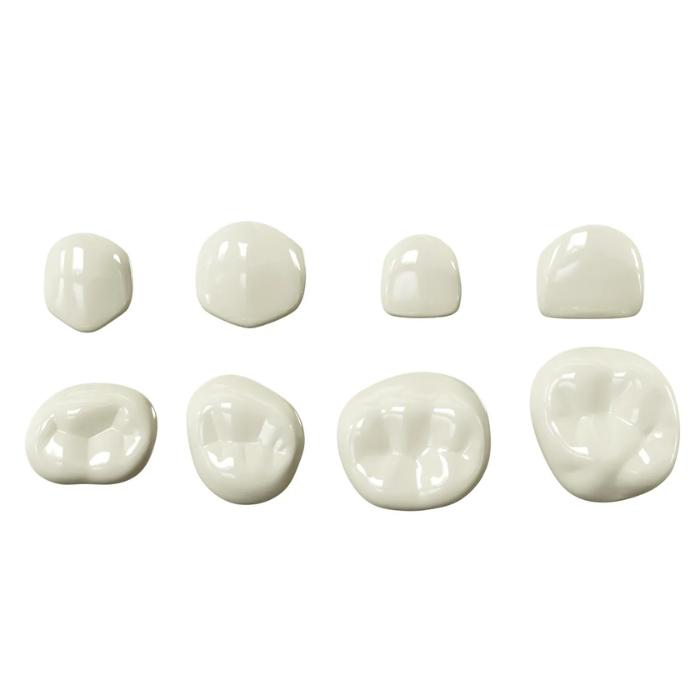Kids-e-Dental Bioflx Anterior Crown Kits
Bioflx Crowns are the world’s first flexible, durable, self-adaptable, and esthetic pre-formed pediatric crowns. Combining the benefits of both stainless steel and zirconia crowns, they provide an innovative solution for pediatric tooth-colored restorations. Invented by a pediatric dentist from India, Bioflx crowns are the ideal full-coverage restoration—offering durability, flexibility, and enhanced aesthetics, making them the preferred choice for pediatric dentists.
Features:
- Metal-free, monochromatic, tooth-colored crowns made from a fully biocompatible material.
- Constructed from a high-impact, biocompatible hybrid resin polymer, commonly used in medical applications requiring exceptional strength, flexibility, and durability.
- Free from Bis-GMA and metal.
- Laser marking on the inner occlusal surface ensures easy identification and optimal aesthetics.
- Uniquely flexible and versatile for effortless placement and a secure, active fit.
- Tooth preparation and handling are similar to stainless steel crowns (SSC), reducing chair time.
- Wear resistance is comparable to or superior to traditional SSCs.
- Instead of wearing down, Bioflx crowns self-adapt by forming a ‘dimple’ in areas of high occlusion.
- Stain-resistant, with no visible discoloration after over a year of intraoral use or when placed opposite an SSC.
- Sandblasted intaglio surface enhances retention with self-setting RMGI & GI cements.
- Suitable for cementation using regular GI (FujiCem I, Ketac) or RMGI (FujiCem II). Light-cured cement is not recommended.
Indications:
Bioflx anterior crowns are recommended for:
- Extensive tooth decay: Ideal for anterior teeth with severe decay that cannot be restored using dental fillings.
- Fractured or broken teeth: Restores strength and functionality to anterior teeth damaged due to trauma or other causes.
- Hypoplastic teeth: Corrects the appearance and function of teeth with developmental defects or hypoplasia.
- Teeth with developmental anomalies: Suitable for conditions such as amelogenesis imperfecta or dentinogenesis imperfecta to enhance aesthetics and function.
- Primary tooth restoration: Used for restoring decayed or damaged primary (baby) teeth when conservative treatments are ineffective.
| Technical Specification |
|
|---|
Bioflx crown anterior starter kit 12 crowns:
- Central incisor- a2, a3, a4 (2 units each)
- Lateral incisor- a2, a3, a4 (2 units each)
Bioflx crown anterior master kit 20 crowns:
- Central incisor- a1, a2, a3, a4, a5 (2 units each)
- Lateral incisor- a1, a2, a3, a4, a5 (2 units each)
Bioflx crown anterior professional kit 32 crowns:
- Central incisor- a2, a3, a4 (4 units each) a1,a5 (2 units each)
- Lateral incisor- a2, a3, a4 (4 units each) a1,a5 (2 units each)
- Tooth Preparation: Begin by preparing the affected tooth according to standard dental procedures. Remove any decayed or damaged tooth structure, ensuring a clean and stable foundation for the crown.
- Crown Selection: Select the appropriate size of Bioflx anterior crown from the kit based on the tooth being restored. Ensure that the selected crown matches the tooth's anatomy and fits snugly.
- Crown Adjustment: If necessary, make any adjustments to the crown to ensure an optimal fit. This may involve trimming or shaping the crown to match the contours of the prepared tooth.
- Etching: Apply an etching gel to the prepared tooth surface.
- Rinse and Dry: Thoroughly rinse the etching gel off the tooth with water and then dry the tooth surface using air or a gentle stream of compressed air.
- Adhesive Application: Apply the adhesive material to the dry tooth surface. Ensure even and complete coverage of the prepared area.
- Crown Placement: Gently place the Bioflx crown onto the prepared tooth, aligning it properly with the tooth's anatomy. Apply gentle pressure to ensure the crown seats are full and accurately.
- Excess Material Removal: Remove any excess adhesive or cement around the margins of the crown using an appropriate dental instrument or dental floss.
- Cementation: Apply the cement material to secure the crown in place.
- Occlusion Check: Verify the occlusion or the way the restored tooth contacts the opposing teeth. Adjust any high spots or interferences to achieve proper occlusion and ensure a comfortable bite.
- Post-placement Instructions: Provide post-placement instructions to the patient or caregiver, including oral hygiene recommendations, dietary restrictions, and any specific care instructions for the restored tooth.
- Self-adaptive technology allows the crown to adjust in areas with slightly high occlusion.
- Radiopacity (~1mm) enables evaluation of crown margins and pulp capping materials.
- Laser marking on the inner occlusal surface ensures easy identification and optimal esthetics.
- Strong yet flexible, ensuring easy placement and a secure, active fit.
- Sandblasted intaglio surface enhances retention with self-setting RMGI & GI cements.
- Can be seated using a bite stick and trimmed if necessary with crown and bridge scissors.
















